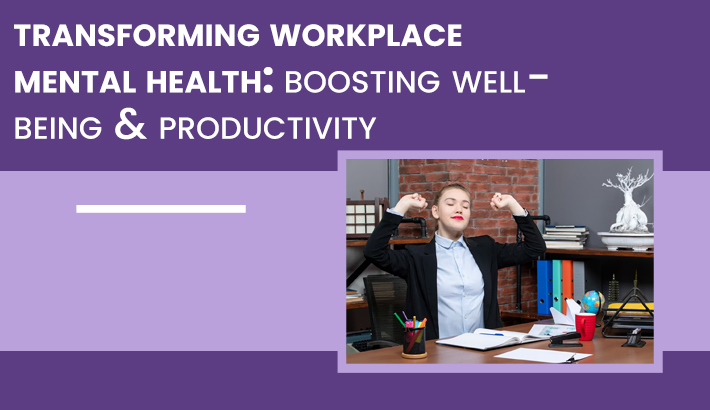In today's fast-paced work environments, employee well-being and mental health have become pivotal to organizational success. Increasingly, companies are recognizing that a mentally healthy workforce is not only more productive but also exhibits higher levels of engagement and loyalty. This article explores the transformative power of techniques aimed at enhancing workplace mental health therapy, leading to improved employee well-being and productivity.
The Impact of Workplace Mental Health
The state of an employee's mental health significantly influences their overall performance, job satisfaction, and engagement. A supportive workplace that prioritizes mental health fosters a positive work culture and contributes to employees' overall quality of life.
Recognizing the Signs of Mental Health Strain
3.1. Behavioral Changes
Uncharacteristic behavior, mood swings, and withdrawal from social interactions can signal underlying mental health challenges.
3.2. Decreased Productivity
A decline in work performance, missed deadlines, and difficulty concentrating may indicate mental health strain.
3.3. Increased Absenteeism
Frequent absenteeism or unexplained sick leaves might be linked to mental health issues.
3.4. Communication Difficulties
Struggling with communication, whether in expressing ideas or collaborating, can be indicative of mental health struggles.
Creating a Supportive Work Environment
4.1. Open Communication Channels
Encouraging open dialogue about mental health removes stigma and allows employees to seek support without fear.
4.2. Mental Health Resources and Programs
Providing access to counseling services, support groups, and mental health awareness programs creates a safety net for employees.
4.3. Flexible Work Arrangements
Allowing flexible work hours or remote work options accommodates employees' diverse needs and reduces stress.
4.4. Training and Awareness Initiatives
Educating employees and managers about mental health fosters understanding and empathy, creating a more inclusive workplace.
Proven Techniques to Boost Employee Well-being
5.1. Stress-Reduction Strategies
Implementing stress-reduction techniques such as time management workshops and relaxation sessions can alleviate workplace pressures.
5.2. Mindfulness and Meditation
Promoting mindfulness practices helps employees stay present, manage stress, and enhance emotional resilience.
5.3. Physical Activity Promotion
Encouraging regular physical activity improves mood, reduces stress, and enhances overall well-being.
5.4. Encouraging Work-Life Balance
Setting boundaries between work and personal life prevents burnout and promotes a healthier work-life balance.
5.5. Fostering Social Connections
Organizing team-building activities and events nurtures a sense of community and belonging among employees.
The Role of Leadership in Mental Health Transformation
6.1. Leading by Example
Leaders who prioritize their mental health set a positive example for their teams, normalizing self-care.
6.2. Providing Emotional Support
Managers who offer emotional support and a safe space for employees to express their concerns contribute to a healthy work environment.
6.3. Empowering Employees
Empowering employees to take breaks, manage their workload, and voice their needs contributes to their overall well-being.
Measuring the Impact and Outcomes
Regular assessment of the impact of mental health initiatives allows organizations to fine-tune strategies and gauge employee satisfaction.
Overcoming Challenges in Implementing Mental Health Initiatives
8.1. Stigma and Fear
Addressing stigma and fear around mental health requires persistent awareness campaigns and cultural shifts.
8.2. Resource Allocation
Allocating resources to mental health initiatives is crucial for sustained success and positive outcomes.
8.3. Sustainable Change
Creating lasting change involves integrating mental health strategies into the core values and policies of the organization.
Future Trends in Workplace Mental Health
As workplaces continue to evolve, trends such as digital mental health tools, virtual well-being programs, and AI-driven mental health support are expected to emerge.
Conclusion
In conclusion, prioritizing workplace mental health is essential for organizations to thrive in today's competitive landscape. By implementing proven techniques and creating a supportive work environment, companies can transform their workplaces into spaces where employees flourish. This leads to increased productivity, engagement, and overall success. It is crucial for organizations to recognize the signs of mental health strain, create a supportive work environment, and implement techniques to boost employee well-being. Leadership plays a vital role in driving this transformation by leading by example, providing emotional support, and empowering employees. Regular assessment of the impact of mental health & wellness initiatives and overcoming challenges such as stigma and resource allocation are crucial for sustained success. Furthermore, with the evolving nature of workplaces, future trends such as digital mental health tools and virtual well-being programs are expected to emerge. Ultimately, prioritizing workplace mental health is not just a trend but a necessity for organizational success and the well-being of employees.
FAQs
Q1. How can employees access mental health resources within the workplace?
A. Most companies offer access to resources such as counseling services, EAPs (Employee Assistance Programs), and wellness initiatives.
Q2. Are there specific industries that benefit more from workplace mental health initiatives?
A. Workplace mental health initiatives are beneficial across all industries, as employee well-being impacts performance universally.
Q3. How can managers approach conversations about mental health with their team members?
A. Managers can create a safe and private space, express empathy, and emphasize that seeking help is a sign of strength.
Q4. What role does corporate culture play in workplace mental health?
A. Corporate culture shapes attitudes towards mental health, influencing whether employees feel comfortable seeking support.
Q5. How can remote work impact workplace mental health initiatives?
A. Remote work requires adapting initiatives to virtual settings, prioritizing regular check-ins, and promoting work-life balance.






Leave a reply